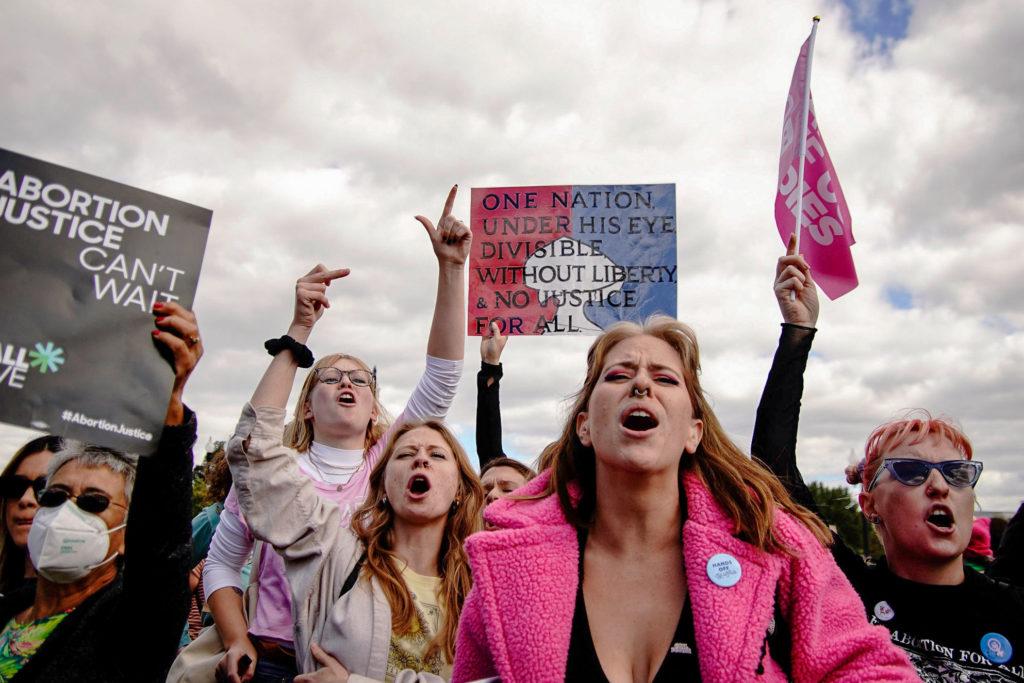Thousands of protesters blocked off streets near the Capitol Saturday, pushing for reproductive rights four months after the overturn of Roe v. Wade.
The Women’s March organization led the protest exactly one month prior to the midterm elections, walking along Washington Avenue before finishing at Union Square. Protesters said electing pro-choice representatives in the midterm elections was their primary inspiration for marching.
The march began with a rally in Folger Park, a couple of blocks southeast of the Capitol, guided by singer and comedian Lea DeLaria, with performances from singers Milck, Biianco and Autumn Rowe, who led the crowds in chants of “we won’t go back” and “this is what democracy looks like” before marching to the Capitol. Protesters wore blue eyeliner and held signs showing blue waves, symbolizing Democratic victories in the upcoming midterms.
[gwh_image id=”1172233″ credit=”Sophie Moten | Staff Photographer ” align=”none” size=”embedded-img”][/gwh_image]
Organizers of the march said each of the speakers included were “very carefully” hand-picked to ensure the messages were relevant to current issues, with representatives from abortion justice group All Above All, the National Women’s Law Center, Planned Parenthood and experts on the Iranian crisis.
Rachel O’Leary Carmona, the executive director of Women’s March, said the march allows different communities to come together in a visible demonstration for a multitude of “leading issues” involving fundamental freedoms like reproductive rights.
“What we’re trying to do is build the momentum necessary to get us through the next four weeks, with our base stirred up ready to go and go out to the polls,” Carmona said.
Autumn Rowe, songwriter and one of the march’s performers, said she remembers going to her first march and feeling comforted by the people who shared her same passion. She said the “best” way she knows how to fight for her rights and be loud is through music.
“Once I saw there was so many other people feeling the same way; we had each other,” Rowe said. “So we’re stronger in numbers, we’re stronger together. And by assembling today, we’re showing that power.”
High school student Ella Barrett attended the march with her mother and Argentinian grandmother, all wearing green to symbolize Argentina’s legalization of abortions in 2020. She said she and her family drove from Pennsylvania to attend the march to advocate for the rights of herself and the people close to her.
“I’m mostly here for my rights when I get older, for my sister’s rights, for my cousin’s,” Barrett said.
Lara Kalin, a stay-at-home mother from Philadelphia, drove her two daughters to the march and said has been working to get more mothers involved in reproductive activism. Kalin said she has attended several marches since the reversal of Roe v. Wade was leaked, and said it was “important” to come to D.C. to protest because she could not imagine her daughters having fewer rights than her.
“I want my daughters to start fighting for themselves early,” Kalin said. “And I want them to see me doing it. And I want them to continue doing it because I have a feeling this is just the beginning for a lot of us. And so it’s important to raise them as fighters essentially.”
[gwh_image id=”1172219″ credit=”Sophie Moten | Staff Photographer ” align=”none” size=”embedded-img”][/gwh_image]
Abigail Brick and Nate King, who work at an abortion clinic in Cleveland, said they came to the march to help big turnouts at protests inspire people to take action and volunteer at clinics across the country.
“It’s very liberating seeing so many different people from so many different places, all for the same cause, it’s very inspiring,” King said.
[gwh_image id=”1172239″ credit=”” align=”none” size=”embedded-img”][/gwh_image]
D.C. resident and software engineer Sonia Glenn said she hoped to inspire other participants with her symbolic outfit marked with blue butterflies and Día de los Muertos face paint. She used butterflies to show women “growing” their rights and bodily autonomy.
“There’s a lot of problems with pregnancy, so there’s a high mortality rate,” Glenn said. “So it’s very dangerous for women to be pregnant and not have the safety-conscious mind that if something goes wrong with your pregnancy, you can end it safely.”
Glenn said she liked experiencing the spirit between participants and the crowd felt ready to raise their voices in unison. She said the energy of the music at the march helped to ignite the crowd while they protested for their rights.
“I mean we are mad, we’re angry because this is our rights, this is our freedom, this is our life,” Glenn said. “But we live here, you know? This is our life. We want to dance, we’re gonna dance because we need to see and feel good about the things, we cannot be sad and angry all the time.”
D.C. resident Meg Clark, who was attending her first women’s march, said seeing generations come together at the march moved her to tears, and said she was mad at the Supreme Court and “men in general.”
“I was quietly mad before, now I’m loudly mad,” Clark said.
Moksha Akil contributed reporting.











